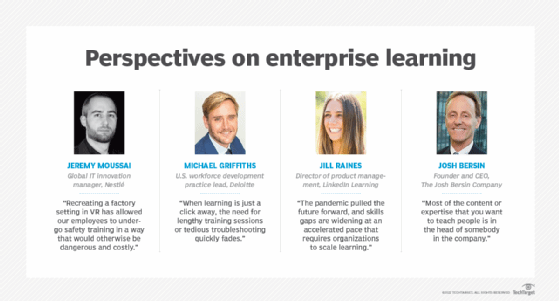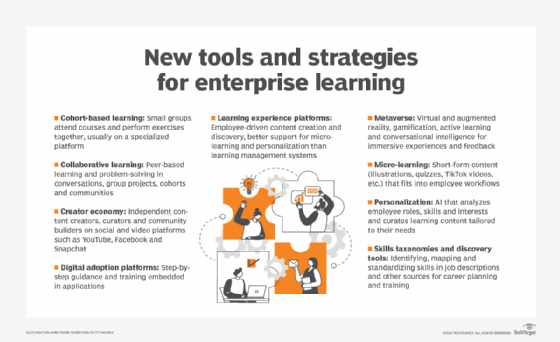New enterprise learning tools put employees in control
The creator economy, peer-based collaborative learning and next-generation content providers are democratizing training and making it more personal -- with a big assist from AI.
Before the COVID-19 pandemic, online learning and a growing category of "learning experience platforms" were already taking off in the enterprise, augmenting and sometimes replacing stodgy learning management systems that had been around for decades.
The ensuing seismic shift to remote work and online collaboration has only accelerated this e-learning trend, transformed emerging technologies and strategies, and made learning a top priority as organizations struggle to find, develop and retain employees. Enterprise learning is evolving to accommodate the educational needs of people who were interviewed and onboarded entirely online and will never work in the office.
Now, the hot trend is about finding ways for employees to teach each other. Cohort, or small-group, online learning is growing along with other collaborative learning approaches. The shift, especially among younger generations, toward consuming and creating short-form videos such as those found on TikTok -- what some experts call the "creator economy" -- is helping organizations tap into the ability of employees to produce instructional content on their own. This trend toward short-form content is unlocking new opportunities for "microlearning" that blends easily into an employee's daily workflow.
All of these factors are leading to a sea change in how educational content is delivered. Indeed, the market for these new learning tools is exploding, according to Josh Bersin, co-founder and CEO of The Josh Bersin Company, a research and advisory firm. He estimated the learning and development technology market will reach $360 billion to $450 billion in 2022.
At the same time, the HR discipline -- especially talent management -- is becoming skills-based. Enterprises face an unprecedented skills gap driven by the rapid evolution of technology, the pandemic, industry shifts, supply chain challenges and new business models.
"The pandemic pulled the future forward, and skills gaps are widening at an accelerated pace that requires organizations to scale learning to keep employees prepared and satisfied," said Jill Raines, director of product management at LinkedIn Learning.

Skills gap drives need for new learning strategies
In response, recruiters are emphasizing proven skills and not just stated qualifications; meanwhile, managers are providing career opportunities to their direct reports by focusing on the skills those employees need to advance. Employee skills databases are being built, and skills taxonomies are being added to in-house and online learning and performance management systems. Now, courses can be indexed and accessed according to the skills they provide and what those skills can do for individual employees and the organization.
Yet, in a recent Deloitte report, "The skills-based organization: A new operating model for work and the workforce," only 14% of executives surveyed said their workers were maximizing their skill sets despite the abundance of emerging tools to help them reach their potential. At the same time, enterprises are discovering that new learning and development opportunities can play a pivotal role in upskilling and engaging employees. Deloitte's "Global 2022 Gen Z and Millennial Survey" found that nearly 30% of respondents chose to work at their current organization because of the learning and development opportunities.
LinkedIn research found that the skill sets for jobs have changed by 25% since 2015 and are predicted to change by 200% by 2027. Raines argued that a new approach is required to keep pace with this widening skills gap. The right learning program not only boosts employee skills but also increases employee satisfaction.
"By encouraging lifelong learning and supporting development throughout employees' careers, our data shows that retention increases," Raines said. This is even more important as new generations enter the workforce. Other LinkedIn research found that 76% of Gen Z employees believe that learning is the key to a successful career, and 40% are willing to accept a pay cut if they think it will lead to better career opportunities, compared to 26% for all workers.
A new role for corporate instructors
But who will lead the charge?
Team leaders tend to be the first to explore new learning content and techniques, which eventually get adopted and integrated into HR-led efforts, Bersin said. This mirrors the broader shadow IT trend, in which business managers go around centralized control to buy the services they need to improve their departments.
In the case of enterprise learning and development, the services can include function-specific training, new learning platforms and new kinds of content. The role of HR then shifts from trying to organize everything upfront to creating the appropriate infrastructure to empower managers and employees to learn the most relevant skills more efficiently and effectively.
"In a digital learning environment, the learning department cannot attend to all [needs] at once," said Michael Griffiths, Deloitte's U.S. workforce development practice lead. "Consequently, chief learning officers and instructors must empower employees and managers to share knowledge and serve themselves to a greater degree."
Organizations must find ways to help their workers adapt to these changes if they want to appeal to a vast talent pool, according to Griffiths. "Organizations and instructors who embrace learning as a platform and can leverage these emerging technologies will have the upper hand in terms of both operational performance and talent retention," Griffiths said.

Pandemic push accelerates e-learning trend
The last two years have forced many businesses to make significant changes to their operations, most notably by moving entire teams and organizations -- often in just a few days -- to remote work environments and adopting digital technologies more quickly than planned. It's also driven them to rethink their training and development processes and put a greater emphasis on reskilling, upskilling and virtual training. Mandated one-size-fits-all programs designed for in-person learning are no longer seen as the best way to help employees discover new skills, identify gaps and reach their potential.
Some companies are already bringing their learning programs in line with these new ways of thinking.
 Piyush Mehta
Piyush Mehta
For example, in 2020 Genpact launched a new learning framework called Genome to support its growing need for remote access. Piyush Mehta, Genpact's chief human resources officer, said the company marketed it to 100,000 virtual employees across the globe.
The level of engagement has been promising, with over 80,000 people learning on the platform monthly. Employees use Genome to learn 550 granular skills across 74 domains. The platform starts by taking a deep skills inventory for specific roles, which helps curate recommendations from over 700 subject matter experts across 75 skills. Genome delivers the content to employees in bite-size chunks, which helps them absorb new knowledge within their daily workflows.
The new approach has dramatically increased the time employees devote to learning new skills, Mehta said. Learning hours per employee increased by more than 60% compared to results from the company's traditional learning management system (LMS).
AI helps personalize learning
Enterprises are also taking advantage of advancements in AI and machine learning technology to improve almost every aspect of learning and development.
 Evelyn McMullen
Evelyn McMullen
"The introduction of AI-based capabilities for things like skill identification and matching, content recommendations and custom learning paths has been an ongoing development," said Evelyn McMullen, research manager at Nucleus Research. McMullen said many organizations realize that investing in new AI tools to improve learning and development was often more cost-effective than recruiting to hire the right talent.
Priyanka Mitra, practice director at advisory service Everest Group, said AI plays a crucial role in shifting learning from a one-size-fits-all approach to a more personalized experience for each employee.
Top use cases include the following:
- Algorithms based on AI and machine learning analyze learners' skills, roles, interests, behavior and search histories to deliver intelligent content recommendations personalized to their needs.
- Smart content discovery, made possible by automated web content curation and AI-assisted content tagging, makes it easier for learners to find content relevant to them.
- AI-powered digital assistants can interact with learners and help them find the right resources.
- AI can deepen skills measurement with adaptive skills assessments and curate learning pathways or journeys for each learner to bridge their skills gap.
- AI can generate predictive analytics that helps organizations discover patterns that connect learning to business outcomes.
AI is also helping trim the fat off the learning experience. "The automation of processes in personalized learning frees up time on both ends to focus on the details that really matter," said Thuy Tran, CTO of Astrid Education, which makes a language learning platform.
 Thuy Tran
Thuy Tran
For example, personalized algorithms can give more precise feedback than outside consultants with less prior knowledge of individual learners. AI can also provide accurate, real-time feedback more efficiently and in ways that manual learning methods cannot, Tran claimed. Such immediate evaluation, alongside personalized content, lets employees learn new skills more effectively, improving productivity and quality of work. Faster, personalized learning can also improve employee engagement and retention, she said.
At the same time, Tran stressed, enterprises could get the most value by finding ways to complement and augment human trainers rather than replace them. "AI should not be seen as an automatic solution to all problems in personalized learning, nor as a replacement for human-to-human learning," she said. "Instead, AI should be harnessed to improve the processes that traditional teaching cannot, including providing recommendations for individualized learning content and pathways, tracking learner progress and providing real-time feedback and support."
Market led by new generation of learning content providers
The whole notion of learning content is undergoing a fundamental change. In the traditional approach, a team of education experts would create a curriculum organized into topics to cover the most general needs. Over the years, enterprise learning providers organized these topics into curated videos for e-learning platforms. But the persistence of skills gaps has demonstrated that the traditional approach can't keep pace.
The market arrived at the same verdict. Bersin said leading content companies such as Netg, Element K, DigitalThink and Learning Tree International have all vanished in the past two decades. A new generation of content providers is emerging to take their place, led by upstarts like LinkedIn Learning, Skillsoft, Udemy and Coursera. These platforms take advantage of innovations in social media, recommendation engines and content creation to create a rich curriculum of enterprise content.
For example, the LinkedIn Learning Hub uses data from 850 million members and 14 million job postings to organize content across 39,000 unique skills in 18 languages. It can also help enterprise learning and development programs identify skills gaps and benchmark themselves against programs in similar companies. LinkedIn Learning can also help curate personalized learning pathways based on each learner's skills, role and goals.
Dawn of the creator economy
No individual or team can set the agenda for this new decentralized approach. A new creator economy is helping to flesh out the best content through better strategies for creating, vetting and recommending content. It mirrors the way Wikipedia exploded beyond the bounds of a few experts into a much broader, emergent collaboration of enthusiastic amateurs.
 Whitney Omosefe
Whitney Omosefe
"The cool thing about the creator economy is that it makes learning much more accessible," said Whitney Omosefe, principal at Omosefe Consulting. For example, learners can use search tools to identify sources and proceed with the most concise and easily digested sources.
Omosefe said enterprises are starting to compare the returns they get from traditional LMSes to newer platforms that help organize, index and access content more efficiently.
Jon Miles, head of technology at Titus Learning, an e-learning consultancy, recommended that learning and development professionals empower subject matter experts within the organization to curate resources they find valuable. This can help ease the administrative burdens and foster a learning culture from within teams rather than relying on the old, top-down method. Newer learning experience platforms (LXPs), such as Totara Engage, help automate the process.
 Jon Miles
Jon Miles
The wealth of content also enables enterprises to discover and prioritize formats that enable employees to learn more in less time. "When learning is just a click away, the need for lengthy training sessions or tedious troubleshooting quickly fades," said Deloitte's Griffiths.
The creator economy has also catalyzed better tools for creating and managing content in-house. "Most of the content or expertise that you want to teach people is in the head of somebody in the company," Bersin said. The knowledge of the best salesperson, engineer or finance professional tends to be more relevant and valuable than that of most external experts. In fact, Bersin found that employees value internal content four times more than externally developed content.
Furthermore, every company has unique processes, customer service models and special products that employees need to understand. Bersin estimated that 70% of this content has to be built internally, which drives a tremendous need for tools for sharing content.
Learning in the flow of work
The arrival of new content creation, curation and delivery platforms has also enabled teams to rethink how they deliver content.
A decade ago, most digital learning involved a minimum of a three-hour course. But employees no longer have time for this. Now, microlearning breaks training down into smaller and smaller pieces, Bersin said.
Shorter lessons have also inspired the notion of learning in the flow of work, in which employees can learn the exact thing they need while doing something, instead of having to divert their attention to a lesson.
The trend is also affecting the formats in which content is delivered. Traditional learning content required employees to open a separate tutorial PDF, webpage or video to learn how to use a software application. Digital adoption platforms can embed the training steps directly inside the application. Vendors such as WalkMe, Spekit and EdCast are integrating these capabilities directly into learning platforms.
Bersin said that only about 5% of companies knew what learning in the flow of work was five years ago. Now, about 15% are familiar with the concept, and it is picking up speed thanks to early successes and better infrastructure and tools.
 Nick Oddson
Nick Oddson
Reimagining the social aspects of learning
Physical classrooms play a vital role in traditional learning. The first generation of e-learning tools made it easier for learners to explore more types of content at their natural pace, but they glossed over the social aspects of learning. New collaborative learning capabilities are starting to combine the best of both worlds.
"Collaborative learning allows for the exchange of ideas, fostering of community and meaningful learning experiences," said Nick Oddson, CTO of D2L, an LXP vendor.
One crucial variant of collaborative learning is cohort-based learning, which replicates the social aspects of the traditional classroom.
In a cohort-based program, employees learn from each other through peer-to-peer learning and by completing exercises together, said Daniel Wirtz, co-founder of Facilitator School, which helps enterprises implement these kinds of programs. It's very different from the typical training format, where the trainer talks and trainees take notes, he said.
 Daniel Wirtz
Daniel Wirtz
The role of the trainer is also very different. Instead of being the "sage on the stage," the trainer acts more like a "guide on the side." Wirtz said interest in this approach picked up after the onset of the pandemic because traditional learning made it hard to keep groups engaged. Cohort-based training offers a way to create more engaging and impactful online learning experiences, he said.
Fran Maxwell, managing director of workforce and organizational transformation at Protiviti, a consulting firm, named several principles to help enterprises make collaborative learning more effective, including the following:
- Align the learning to the work the employee is actually doing.
- Focus the learning on the times the employee needs the most support and guidance, which will increase the chances of development and growth.
- Allow time for conversations and discovery among employees. You must plan and account for this time or employees will feel the company isn't serious about peer-based collaborative learning.

LXPs emerge as preferred vehicle
Enterprises adopted LMSes to bring order to a formalized learning process built around preorganized content. But the creator economy has fueled the rise of LXPs as the best vehicle for personalizing learning across content organized on the fly as it is created.
 Fran Maxwell
Fran Maxwell
Protiviti's Maxwell said LXPs flip learning to focus on each employee's needs, using AI to identify, outline and personalize the upskilling they need to meet their goals. He said traditional LMSes still have a valuable role in managing required courses for certifications, ethics and compliance.
LXPs also help enterprises embrace a much more granular approach to skills, said Deloitte's Griffiths. A recent Deloitte report found that 89% of executives believe skills-based practices are becoming more critical to making decisions about work, talent deployment and career management.
"[The] LXP is a fresh approach to corporate learning that is helping enterprises improve employee experience and acquaint their employees with the skills of the future," said Everest Group's Mitra. "They mark a shift to a pull-based learning strategy, which gives more control to the learner and expands learning opportunities."
 Priyanka Mitra
Priyanka Mitra
Mitra cited these commonly used capabilities of LXPs:
- personalized learning from AI-powered content recommendations;
- content sourcing and discovery, and the ability to collate content from various sources;
- simplified integration with collaboration and communication tools and enterprise applications; and
- analytics for better understanding learner behavior and goals.
Skills taxonomies and discovery tools address complexities
The boom in learning platforms and content providers has led to a rapid increase in the number of skills and, more importantly, what they mean. Each tool might have its own rich way of describing skills, which can create confusion for HR teams when they try to identify where to focus their training and recruitment efforts.
In response, enterprises are starting to develop skills taxonomy programs to help harmonize internal company needs with the different ways that tools represent skills, Bersin said. New AI-based skill discovery tools from vendors such as Degreed, LinkedIn, EdCast, Skillsoft Percipio and IBM might help automate the process.
These tools can also help map capabilities and skills gaps in individuals, teams and entire organizations to help prioritize recruitment and training efforts. Bersin said this kind of analysis is also guiding companies to create "capability academies" that focus on the combination of skills, knowledge and experience employees need to succeed. A capability is a cluster of skills employees need to do meaningful work. For example, a semiconductor manufacturer planning a major expansion might identify new chip design capabilities as critical to its plans.
"Every company has these new domains that suddenly just sweep across their industry," Bersin said.
Metaverse technologies enable new interaction patterns
While reading, listening and watching will continue to play an essential role in the learning process, enterprises also need to consider a variety of new options in the virtual world known as the metaverse. Learning experts are exploring new interaction patterns that emphasize direct experience more than rote knowledge and could be more effective at helping workers learn skills -- particularly soft skills.
 Dan Priest
Dan Priest
Techniques like active learning are more hands-on. Gamification adapted from social media can boost engagement. Conversational intelligence capabilities can help personalize targeted feedback for frontline employees in sales, customer service and support roles. And virtual reality (VR) and other metaverse technologies enable immersive experiences that could improve employee engagement and understanding.
Dan Priest, PwC's cloud and digital leader, said learning by listening is ideal for increasing knowledge, but active learning is more important for learning applications. However, few organizations have tools for measuring the applied skills required to deliver a specific business capability. This makes it harder for them to evaluate the time and cost difference between hiring for, contracting for or training people in particular skills, which has been a significant issue for many organizations, he said.
Gamification can drive progress in learning -- up to a point. "In most cases, gamification is a powerful catalyst for end-user adoption of learning systems and programs," McMullen said. Nucleus Research found that learning-focused gamification consistently yields positive ROI because it promotes friendly competition that drives participation. Recognition badges, prizes and leaderboards can bring users into the fold, but each company needs to communicate with employees to determine whether it is something that creates value or is a distraction.
 Mary Charles
Mary Charles
Conversational intelligence tools can listen in on conversations to assess how employees sell products, support customers and resolve problems. Mary Charles, senior director of sales enablement at Allego, a sales enablement platform provider, said conversational intelligence could help identify skills gaps, prescribe training to fix problems and extract best practices from the most successful employees. It can also provide virtual coaching for new employees or when someone experiences challenges in certain situations.
New VR and extended reality (XR) hardware and software should make it easier to embed the metaverse into training experiences. "Using the metaverse as a training or onboarding medium helps to make enterprise learning experiences more immersive," said Mike Buob, vice president of experience and innovation at Sogeti, the IT services division of Capgemini. Manufacturers can simulate complex machinery, field service workers can virtually repair new equipment and employees can practice customer interactions in a simulated world.
 Mike Buob
Mike Buob
This type of training lets employees actively learn tasks in a safe environment while still providing them with valuable skills and experiences. Moreover, training and onboarding workers in the metaverse can help organizations improve employee retention and customer satisfaction rates, which positively impacts the bottom line.
Jeremy Moussai, global IT innovation manager at Nestlé, helped implement training programs on the Immerse VR platform to improve customer service and health and safety.
"Recreating a factory setting in VR has allowed our employees to undergo safety training in a way that would otherwise be dangerous and costly and with uninterrupted operations," Moussai said. "We did not have to sacrifice production to conduct training. All the while, we are able to capture more meaningful data from our global workforce that's centralized in the platform."
Next step: Consolidating the tools
As the landscape of learning technologies, content, platforms and tools expands and becomes more varied, the challenge for learning and development professionals will be simplifying and harmonizing them.
Bersin observed that the classic pattern in the training industry is for innovators to adopt bold new ideas like VR. Then a few department heads adopt the tools to give their teams a competitive edge. HR ignores the innovations until they become mainstream.
A better approach, he said, is to incorporate new learning capabilities into a consolidated enterprise platform, which helps reduce costs, improve data sharing and streamline learning and HR processes.
"A lot of innovative ideas start in the edges of the training function and then make it into the corporate infrastructure because companies don't like to have 50 different tools that don't talk to each other. It's a waste of time and money," Bersin said.
Each organization will need to develop its own path in consolidating the new learning tools to improve training, development and recruiting efforts. Human capital management and LMS leaders are already buying or building these next-generation capabilities, and vendors are starting to consolidate their offerings.
It will be up to learning and development leaders to strike the right balance between maintaining order and inspiring employees to explore the cutting edge.







